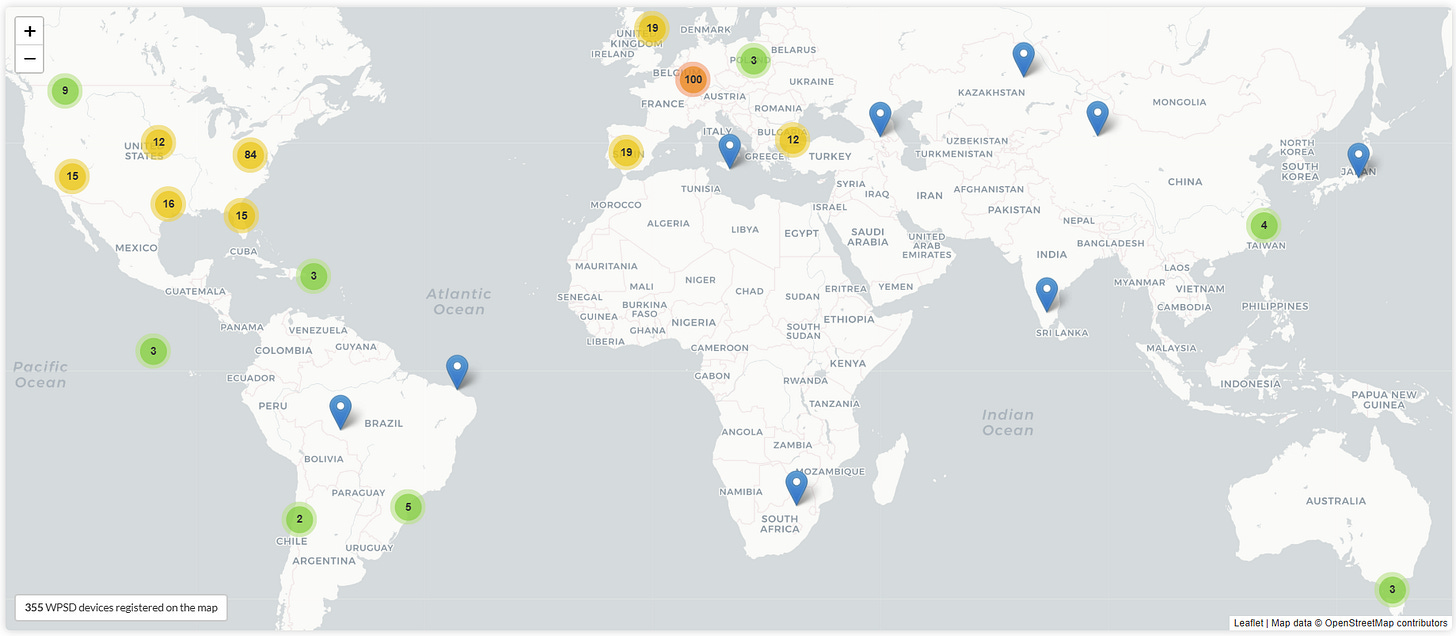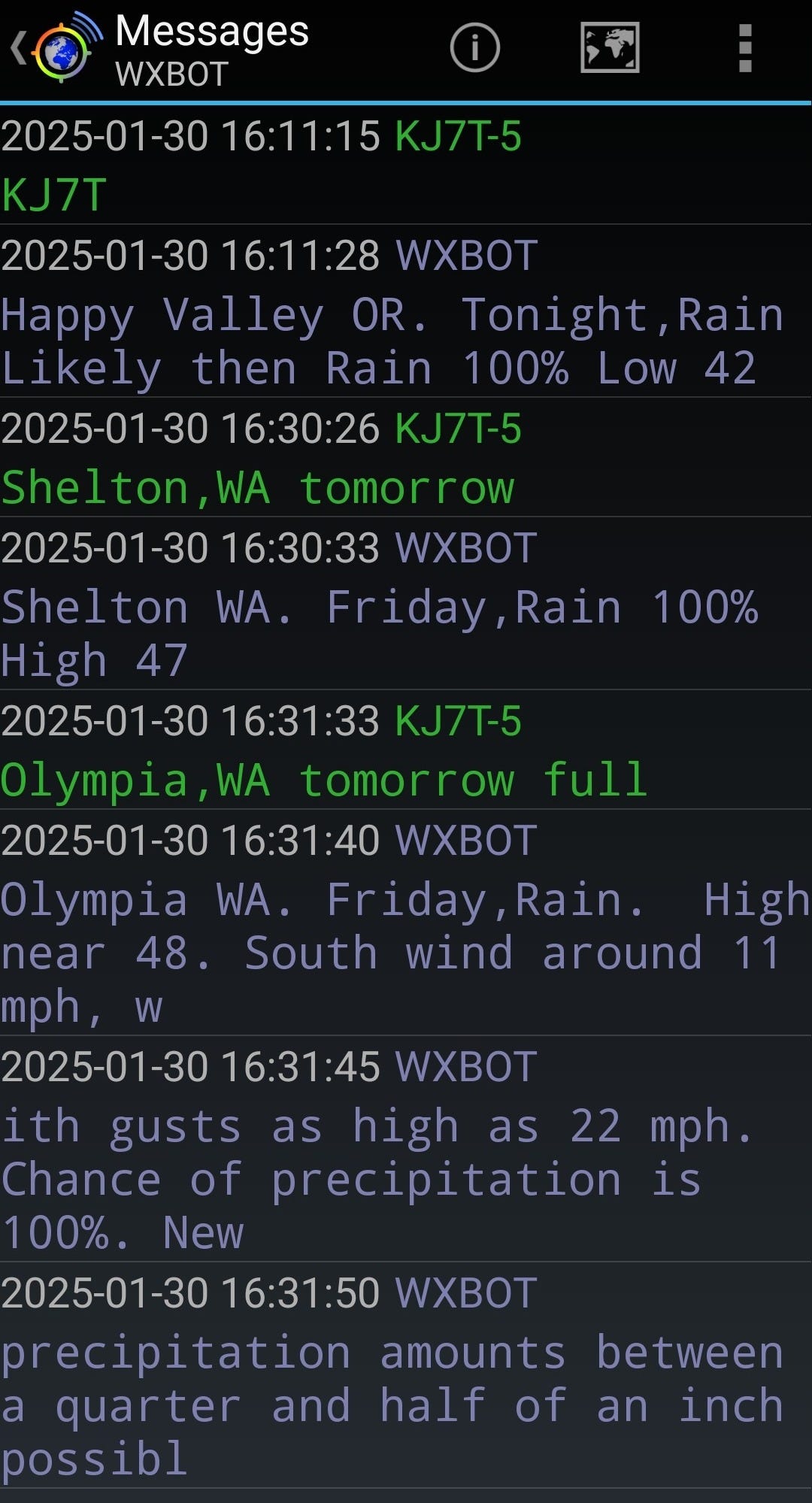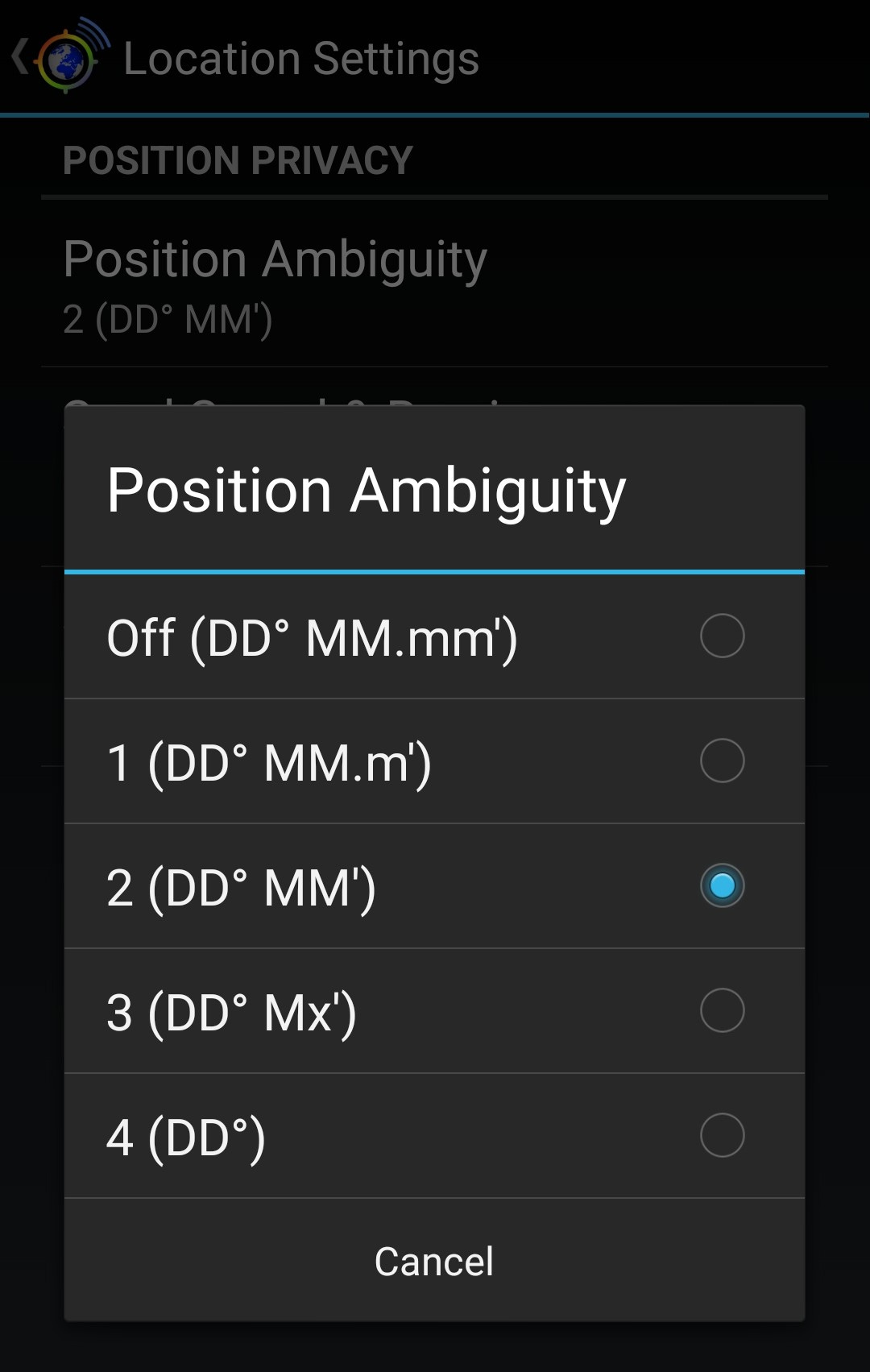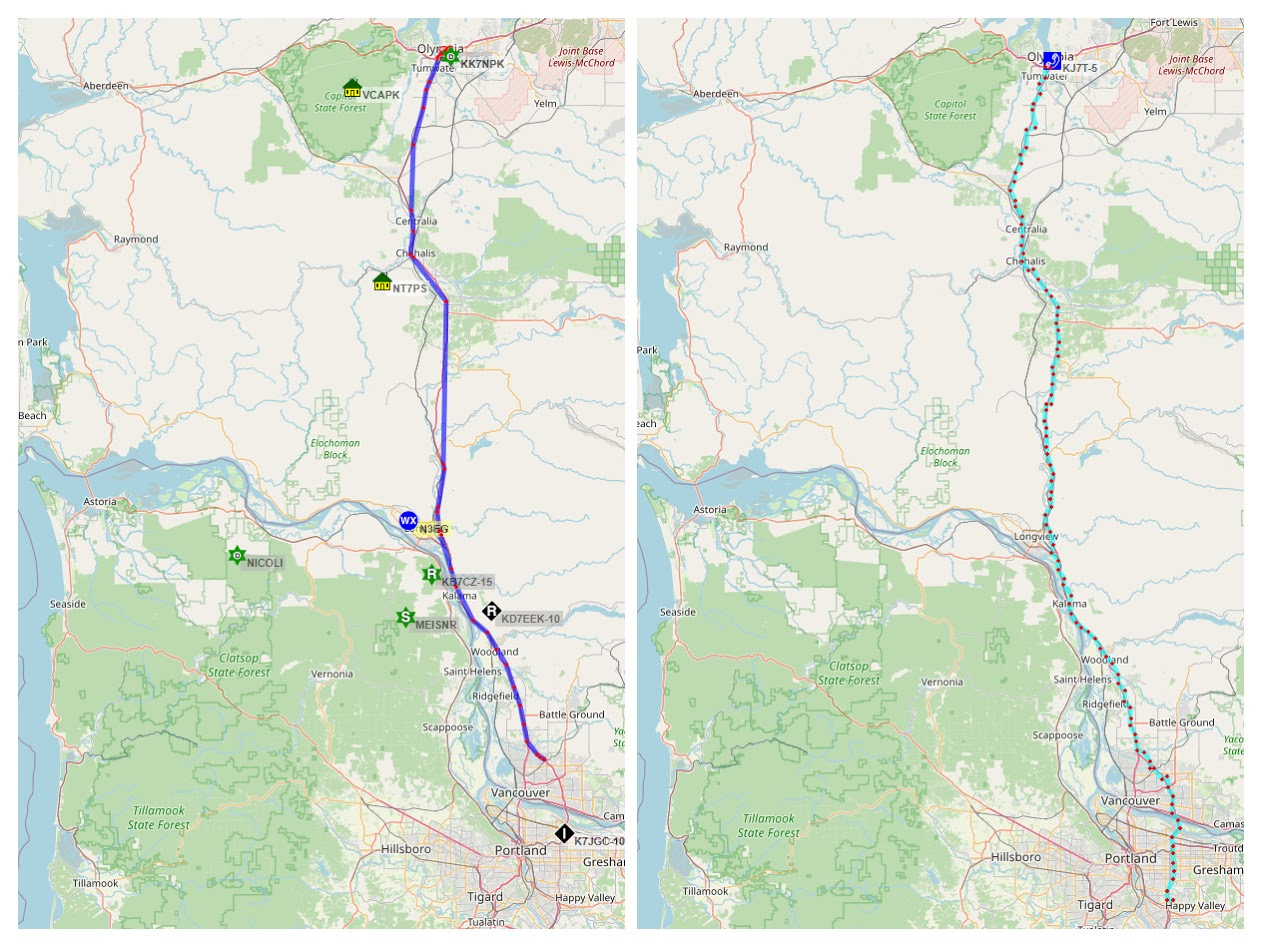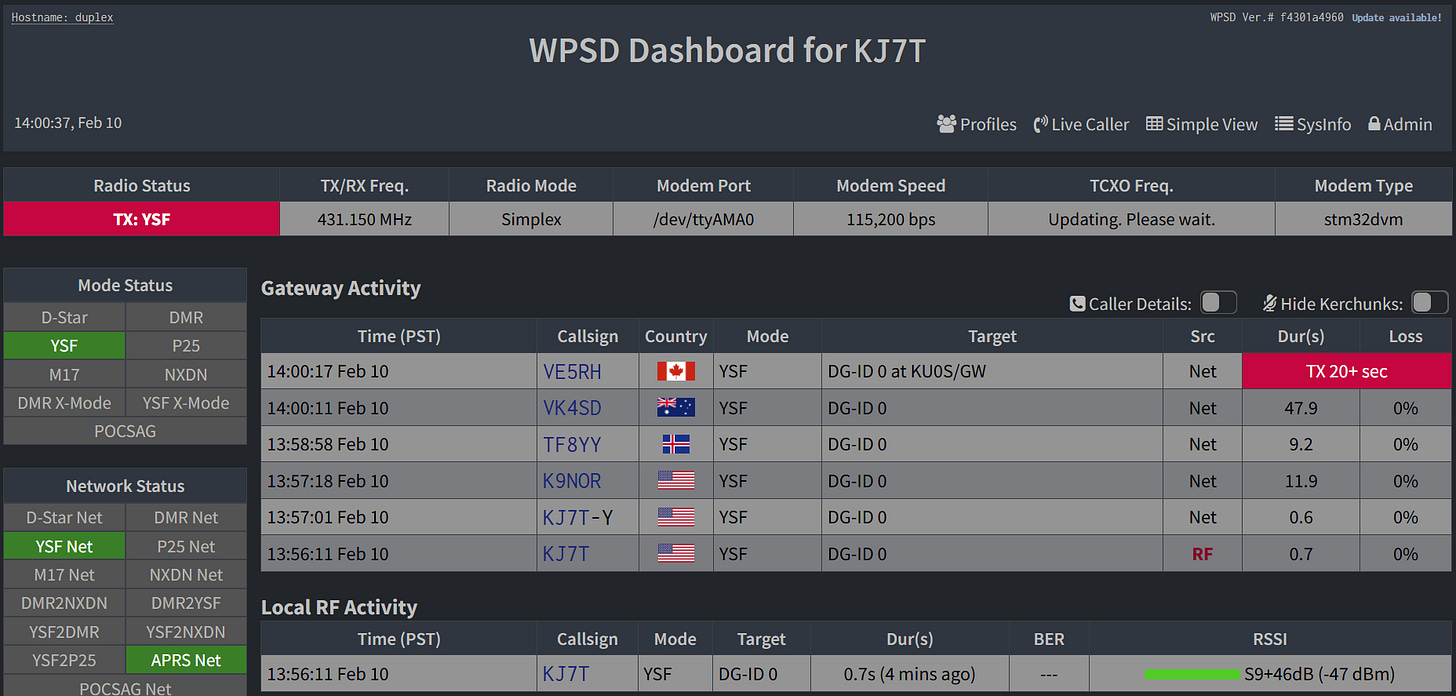Random Wire Review: Issue 120
February 14, 2025: Random Wire recommendations. ASL audio problem update. Additions to WPSD hotspot software. Satellite tracking. New/old computer. AllStarLink, APRS notes. Testing a travel router.
Contents
0. Welcome
1. AllStarLink audio transmit issue resolved
2. Portable WIRES-X with the FT5D
3. Two additions to WPSD hotspot software
3.1 The WPSD user map
3.2 Show phonetics in the WPSD dashboard
4. Real time satellite tracking
5. I got a new-old computer
5.1 Requirements and desirements
5.2 Dell OptiPlex 7050 SFF
5.3 Discussion
6. AllStarLink notes
6.1 Remote control of AllStarLink node
6.2 AllStarLink nets
7. APRS notes
7.1 Get weather forecasts with WxBot
7.2 APRS RF vs. APRSdroid
7.3 Send APRS position with JS8Call
8. What is in your night sky?
9. Tailscale subscription upgraded
10. Miscellaneous
10.1 Notepad++ “Folder as a Workspace” and Markdown
10.2 On the road with the AX1500 router
11. Closing
.-. .- -. -.. --- -- / .-- .. .-. . / .-. . ...- .. . .-- / -... -.-- / -.- .--- --... -
0. Welcome!
Welcome to the Valentine’s Day edition of the Random Wire. I am publishing this a bit early since my week is going to fill up quickly and I’m not sure when I’ll get home on February 13th. Better to get this out the door as soon as it is baked!
Surprisingly, there are not one but two things with the Random Wire Recommended! sticker in this issue.
Random Wire Recommended! awards go to equipment, tools, software, and services that I find invaluable, reliable, and affordable. I believe you won’t be disappointed if you try anything labeled as Random Wire Recommended!
.-. .- -. -.. --- -- / .-- .. .-. . / .-. . ...- .. . .-- / -... -.-- / -.- .--- --... -
1. AllStarLink audio transmit issue resolved
Lately, it seems that each time I publish a Random Wire newsletter, a new update to the AllStarLink audio problem surfaces within a day or two. This is a good thing because it demonstrates the vitality of the AllStarLink community.
This audio issue has evolved quickly. Just after Random Wire issue 119 was published, new information surfaced that the transmit audio problem for AllStarLink running on Debian 12 platforms based on AMD64 processors was showing up on ARM64 processors, i.e., Raspberry Pi SBCs (single board computers).
Then N8EI, an AllStarLink community forum admin, posted a workaround that several people reported did work.
As soon as I began to write this section of the Random Wire newsletter, N8EI posted a “hotfix” at https://community.allstarlink.org/t/audio-problems-similar-to-x86-64-latest-kernel-in-latest-raspberry-pi-appliance-kernel/22829/12.
AllStarLink is releasing an updated asl3 package directly to the main production package stream. This package contains the fix for the stuttering/choppy audio…
And then…a real fix: AllStarLink v3 Critial Software Update Released - 2025-02-01. If you previously applied the hotfix for AMD64 or ARM64 devices, additional steps are required. I recommend reviewing this forum post.
The published instructions did not work well for me, but bear in mind that I usually use apt-get instead of apt. With apt-get, ASL3 did not install for me, so then I had to manually unhold the held packages to proceed:
sudo apt-mark unhold $(apt-mark showhold)After rebooting the node, running sudo uname -r returned 6.1.0-30-amd64. I then tested audio using the Enhanced Parrot at node 55553 and my transmit audio sounded quite clean.
With two other nodes, the published process worked perfectly when I used apt instead of apt-get. The takeaway: follow the published instructions!
.-. .- -. -.. --- -- / .-- .. .-. . / .-. . ...- .. . .-- / -... -.-- / -.- .--- --... -
2. Portable WIRES-X with the FT5D
This content has been planned for a few months but I have not been able to proceed because my WIRES-X registration has not been processed by Yaesu. Once that happens, I’ll publish a how-to on using WIRES-X on a Yaesu FT5D handheld as a TechNote.
(Post-publication update: the WIRES registration arrived on February 11th while I was in Salt Lake City.)
.-. .- -. -.. --- -- / .-- .. .-. . / .-. . ...- .. . .-- / -... -.-- / -.- .--- --... -
3. Two additions to WPSD hotspot software
3.1 The WPSD user map
On a recent net, I learned I could enable location information on my WPSD hotspot. This setting is new in the Configuration menu.
I did that and it works great. Here is my local map:
And here is a world map:
Remember, though, this is not APRS. The only stations you’ll see are those using WPSD software where the hotspot owners have opted in to allow displaying their location. Still, it’s a great step forward and I welcome it.
3.2 Show phonetics in the WPSD dashboard
The other new setting is showing call signs on the WPSD dashboard with phonetics. This is found in the Admin section in the Appearance Settings:
When enabled, phonetics looks like this:
I prefer the more compact view without phonetics, so this ability will remain disabled on my hotspot. It is, nevertheless, a nice feature.
.-. .- -. -.. --- -- / .-- .. .-. . / .-. . ...- .. . .-- / -... -.-- / -.- .--- --... -
4. Real-time satellite tracking
Are you into satellites and want to know what is happening above you, without having to install software? Check out the N2YO website at https://www.n2yo.com/. It features real-time satellite tracking along with a steady stream of satellite-related news.
The “What’s up in your sky?” page is at: https://www.n2yo.com/whats-up/
There is a lot of information available at the N2YO site. If you are interested in satellites, it’s a great website to bookmark.
.-. .- -. -.. --- -- / .-- .. .-. . / .-. . ...- .. . .-- / -... -.-- / -.- .--- --... -
5. I got a new-old computer
5.1 Requirements and desirements
I needed a reliable-but-inexpensive computer for work that could handle word processing, spreadsheets, and occasional light image and audio editing. My needs-and-wants list was relatively short:
Intel i7 or better CPU
Dual display capability
32 Gb RAM, minimum
512 Gb SSD or NVMe storage, minimum
Relatively power efficient
Not full sized and not a micro
5.2 Dell OptiPlex 7050 SFF
What I settled on is a refurbished Dell OptiPlex 7050 in the small form factor configuration:
A similar machine is available on Amazon:
(I didn’t see the one on Amazon when I was shopping. I could have saved $10!)
5.3 Discussion
5.3.1 System notes
The Intel graphics chip isn’t suitable for gaming which is fine because this is a work machine. The 7050 has one HDMI port and two DisplayPort ports, so I think I can hook up my two monitors with an HDMI-to-HDMI cable and a DisplayPort-to-HDMI cable.
This platform is nothing fancy. Rather, it feels more like an old reliable tractor that just works when you need it. These OptiPlex platforms are famous for their reliability. It seems fast enough to not be too frustrating to operate. Some of the USB ports are version 3.1 which are plenty speedy for my purposes. I also wanted a USB-C port which this platform has on the front panel.
I also like that it has an easy-open case. You’d think this isn’t a big deal but I like to keep the inside of the computer clear of dust, so being able to easily access the interior makes it more likely I’ll actually keep it clean.
What I wanted was a platform with an AMD Ryzen CPU but I wasn’t finding anything desirable at the price point I had in mind. I have two nearly identical HP desktop computers that are aging out, and while the one with the Intel chip got tired a few years ago, the one with the AMD chip is still cranking along…but it is starting to stumble. The Dell OptiPlex 7050 replaces the HP desktop.
5.3.2 PC has a real DB9 serial port
From a ham radio perspective, the 7050 also has a real DB9 serial port so maybe at some point in the future I can repurpose this PC to work with some of my legacy radio gear. More specifications are available in the owner’s manual.
This 7050 comes with a one-year warranty so I feel a little safer in purchasing this refurbished machine.
5.3.3 No Bluetooth!
Interestingly, the Realtek RTL8821CE wireless LAN 802.11ac PCI-E card does not seem to have Bluetooth enabled. I haven’t figured this out so I took the easy road and ordered a TP-Link Bluetooth USB adapter from Amazon for less than $10:
I need Bluetooth for some of my peripherals, including Bluetooth headphones and earbuds.
The 7050 has been running 24x7 now for about two weeks. It is faster than the machine it replaces which had an AMD Ryzen 5 chip in it. That seems a bit odd because the Ryzen chip had more cores and more threads available, but the clock speed of the Intel chip in the 7050 is making up for having fewer cores and threads.
For $250, this was a good purchase. The PC is not really very modern and certainly not flashy, but it is a solid performer that I expect to be stable and reliable for quite a while.
.-. .- -. -.. --- -- / .-- .. .-. . / .-. . ...- .. . .-- / -... -.-- / -.- .--- --... -
6. AllStarLink notes
6.1 Remote control of AllStarLink node
I’ve had the Node Remote app on my Android phone for quite some time. As I prepared for my Salt Lake City trip, I thought I’d pull it up and make sure it was working well.
As I looked at it again, I realized this particular app doesn’t have much utility for me. What it does is let you control connections to your node from your smartphone. However, I can just as easily open the AllScan implementation for my node on my phone to handle connecting and disconnecting to nodes. In other words, I don’t need a separate application to do that.
Node Remote doesn’t let you pipe audio to your phone. It just controls connections. I have too many apps as it is so this one is coming off my phone.
For traveling, I’m happier with DVSwitch Mobile, particularly in Web Transceiver mode. (See TechNote #4 for more on DVSwitch Mobile.)
6.2 AllStarLink nets
I can’t vouch for every net included in this list, but it’s a great starting point if you are looking for regular AllStarLink nets:
https://kc3cduonline.wordpress.com/are-there-any-good-allstar-nets/
When you get to that page, keep scrolling. There are quite a few listings!
.-. .- -. -.. --- -- / .-- .. .-. . / .-. . ...- .. . .-- / -... -.-- / -.- .--- --... -
7. APRS notes
7.1 Get weather forecasts with WxBot
Somewhere along the line, I missed learning about the WXBOT! Such a simple-but-great little tool. You send an APRS message to WXBOT with your call sign in the message body (for example: WXBOT KJ7T), and you’ll get a brief weather report back for the place your call sign is registered.
You can also specify a location and timeframe. The image below shows three tests: using my call sign, specifying a different city and tomorrow, and specifying a different city tomorrow and a “full” report:
In the first example below, I sent my call sign to WXBOT. (What I sent is in green and the responses are in light purple.) Interestingly, it returned the weather for where I was at that moment, not for the city where my call sign is registered. I’ll test this from another city soon.
In the second example, I sent Shelton, WA with a timeframe of “tomorrow.”
In the third example, I sent Olympia, WA as the location with a timeframe of tomorrow, and specified a “full” report. (There is an “e” missing from the word “possible” because that was on the next screen.)
These tests were done using APRSdroid on my Android phone. Learn more about WXBOT at https://sites.google.com/site/ki6wjp/wxbot. WXBOT is a handy little tool.
That’s a pretty handy service, especially if you roam off the beaten path.
7.2 APRS RF vs. APRSdroid
These are the tracks from a recent trip between SE Portland and Olympia. I was running APRS on 144.390 MHz using my Yaesu FTM-300DR mobile radio. At the same time, I had APRSdroid on my Android smartphone set to tracking. (For the record, I generally have APRS running on my mobile radio while traveling. This gives my family one more way to find me if the unthinkable happens.)
APRSdroid was set to obfuscate my actual location a little bit (I am using the latest APRSdroid release from NA7Q). In APRSdroid Preferences, tap Position privacy and then Position Ambiguity. I selected option 2 for this exercise.
You can see how the points jump around, especially compared to the tracks from my Yaesu FTM-300DR mobile radio. The Yaesu track is the left side in the image below and APRSdroid points are shown to the right.
The other thing you’ll notice in the comparison above is how few points are tracked with the mobile radio over RF vs. the many points tracked with APRSdroid through the cellular network. At least for the stretch between Portland, Oregon and Olympia, Washington, you’ll get much better coverage with APRSdroid as long as the cellular network is operating. I like having both options available.
This expanded view illustrates what position ambiguity looks like:
You can see that the position ambiguity setting is causing my track points (the red dots on the cyan line) to rarely be on the freeway (the pink-colored line) where I was actually traveling. Instead, they are usually off to one side or the other. Obviously, if you are using APRS to provide location data so that you can be found, you won’t want to use position ambiguity. But if you want a bit more privacy than would be provided by exact positioning, position ambiguity does offer some “location obfuscation.”
7.3 Send APRS position with JS8Call
I ran across this and found the idea intriguing. I wonder if Random Wire subscribers have thoughts on this approach!
.-. .- -. -.. --- -- / .-- .. .-. . / .-. . ...- .. . .-- / -... -.-- / -.- .--- --... -
8. What is in your night sky?
SkyView (available on Google Play and in the Apple Store) appears to be “the” app for those interested in the night sky.
The free, Lite version of SkyView doesn't contain any ads but does count fewer stars, constellations, and other space objects than the paid version. There are extra packages available to purchase containing extra stars and satellites as well as a music package. The full, paid version of the app costs $1.99. I like this app so much I opted for the upgrade.
Comparing the free version to the premium version, I can verify that the upgrade adds a lot more stars and planets to the display. If you’ve ever wondered what constellation is slowly rotating above you, SkyView is an app you’ll enjoy.
.-. .- -. -.. --- -- / .-- .. .-. . / .-. . ...- .. . .-- / -... -.-- / -.- .--- --... -
9. Tailscale subscription upgraded
I have been feeling guilty about not paying for Tailscale. The free personal plan has been a go-to tool for me. Every once in a while, I move a backup of my work computer data to one of my servers. This backup travels from my network in Olympia to my home server in Portland. That, to me, constitutes a business use of the software, so I should be paying the business rate for it.
And I have done that. For $6/month, I get access to Tailscale and a clear conscience. Tailscale pricing is available at https://tailscale.com/pricing.
If you couldn’t tell by the “44 of 110” devices on Tailscale, I’m a big fan. It lets me easily connect my computers and nodes, even across far distances and different networks.
Tailscale is Random Wire recommended!
.-. .- -. -.. --- -- / .-- .. .-. . / .-. . ...- .. . .-- / -... -.-- / -.- .--- --... -
10. Miscellaneous
10.1 Notepad++ “Folder as a Workspace” and Markdown
I could use Joplin (one of my favorite tools) to capture ideas and begin to sketch out the flow of my Random Wire newsletters — and in truth, I have done exactly this — but I also use Joplin for a bunch of other tasks. With thousands of individual notes in my Joplin stack, it gets a bit muddled and busy, so much so that sometimes I miss seeing my Random Wire notes.
Enter Notepad++. This Windows-only freeware utility has been a mainstay for me for years. I use it for text files, PHP files, and HTML, and sometimes I’ll open an unknown binary file in it to inspect the contents.
Notepad++ is a free (as in “free speech” and also as in “free beer”) source code editor and Notepad replacement that supports several languages. Running in the MS Windows environment, its use is governed by GNU General Public License.
What I missed along the way is that Notepad++ has the ability to organize individual files into workspaces that one can organize in hierarchical trees, like File Explorer.
Now add to this my recent dive into looking at Markdown editors which proved less than satisfying. If Notepad++ can handle Markdown and I can store files in a logically organized tree, well, that’s good enough for me.
It turns out that Notepad++ does have Markdown baked in, and with the addition of a free markdown viewer plugin (and there are many plugins available), I can write in markdown and see how it will render as HTML. What this means is I don’t have to add yet another program to my already too-long list of applications on my computer. Instead, I can use a trusted, reliable friend: Notepad++.
Below, you can see the folder panel to the left, the Notepad++ editor in the middle panel, and the markdown viewer rendering in the right panel. You might be able to see — just above the upper left corner of the Markdown Viewer window — a small black icon that is highlighted in light blue. That’s the button in the icon bar that turns Markdown Viewer on and off. One click. Easy.
Since I move around a lot, I am keeping my Notepad++ “folder as a workspace” notes in OneDrive so I can access them anywhere. This is a simple, robust solution for me. I get the ability to organize my notes into folders that can be nested in a hierarchical tree. If one is trying to write a research paper or a book, this kind of organization would be very helpful.
I can write in Markdown and then see how it looks, and even export the rendered file in HTML or PDF. Best of all, I already had most of these pieces in my tech stack.
Notepad++ is Random Wire recommended!
While I was at it, I checked out some additional Markdown editors. Here’s a free one that is cross-platform (Mac, Windows, Linux) and works well on my Windows 11 laptop: MarkText (or check out the MarkText GitHub page).
10.2 On the road with the AX1500 router
I started writing this piece a few days into my Salt Lake City trip. I brought the TP-Link AX1500 travel router with me to protect my compuer and phone while working in my hotel room, and to use with my Yaesu System Fusion hotspot.
10.2.1 Setting up the AX1500
The AX1500 has two Ethernet ports: a WAN port that connects the router to the internet if a working Ethernet port is available in the hotel, and a LAN port that can provide Ethernet when you are connecting wirelessly to the hotel network. It is this latter feature I wanted to test.
Why would a physical Ethernet connection matter? Because running a hotspot in a hotel room and connecting wirelessly to a node or hotspot is usually an exercise in frustration for me. The IP address of my hotspot (configured at home) is not in the same range as the hotel’s network, so getting the node/hotspot authenticated has, in the past, taken up far too much time. Often, I simply fail to figure it out.
When there is a physical Ethernet connection available, a simple “dumb” switch can split that connection into several, with one for the node/hotspot and one for my laptop. Years ago, having that physical Ethernet port available was relatively common. Now it is uncommon, with wifi networking taking its place.
I purchased the AX1500 router to help me solve this problem. Once connected to the hotel wifi, a short Ethernet cable between the router and my hotspot works perfectly to bring my node/hotspot into the IP range of my laptop. Connecting my computer and hotspot to the travel router means those devices are in the same IP address range, making it easy to connect and control devices.
To be clear:
I connected my laptop to the unsecured hotel network.
Then I booted up the AX1500 travel router and configured it to use the hotel connection. This step is necessary because most hotels use captive portal techniques to try to force you to reauthenticate every time you use their network. With the router, once it is authenticated, it usually stays connected for days at a time. And that means the devices connecting through my router do not have to reauthenticate to the hotel network.
I connected the hotspot to the router with an Ethernet cable, then powered up the hotspot. After a few minutes, I found the IP address of the hotspot using the Advanced IP Scanner application on my computer.
Once I knew the IP address, I could log into my hotspot (running WPSD software) to link to specific Yaesu System Fusion reflectors. For example, linking to YSF32453 gives me access to the Kansas City Wide system.
For me, one of the best features of this approach is convenience. I’m four days into my Salt Lake City trip as I write this, and I’ve had to authenticate to the hotel network just once, on the first day. Since then, the router has been running 24x7 and I’ve not had to reauthenticate any of my connected devices. This seems like a small thing but for me, it saves me from significant frustration. The entire time, I’v also been running a VPN client on the router, so all my connected devices are using a VPN-tunneled connection. Nice.
10.2.2 SHARI node through AX1500
I also connected my Kits4Hams PiZero SHARI node to see if it worked the same way in the hotel room, and yes, it does. However, the audio through the SHARI node was horribly garbled. In contrast, the audio through the hotspot and Yaesu FT5D was good.
I’m sure the problem is with my SHARI node because I tested with DVSwitch Mobile on my smartphone. Audio through DVSwitch was quite clear but the same net on the SHARI node was unintelligible. I did find one AllStarLink reflector that did not like my DVSwitch connection, but by connecting through my node-in-the-cloud 57945, I could then link 57945 to that other reflector and listen in via DVSwitch on my phone.
(A hidden benefit of this roundabout way of connecting is that because I’m using my phone, I can use my Bluetooth earbuds to listen. I’m sure the people in neighboring rooms must appreciate this!)
What could cause such bad audio, I wondered. Since I didn’t bring a backup microSD card with me, I worked on what I could do: I swapped in a different wall wart power supply and I switched the microUSB-to-Ethernet adapter to a different port. One (or both) of those changes worked and the audio cleaned up nicely.
Here is the PiZero SHARI node receiving AllStarLink node 2195 after I resolved my audio problem. I recorded the audio on my smartphone in a hotel room with some background noise, but hopefully little of that background disturbance will come through.
10.2.3 YSF hotspot through the router
I also connected my home-built hotspot (set up for Yaesu System Fusion) to the AX1500 router. The audio has been good. A few people noted that my audio level seems low so I’ve increased the microphone sensitivity on the Yaesu FT5D handheld to the maximum level.
This audio came over the Kansas City Wide network. (In WPSD, I linked to the YSF32453 system, which is KC-WIDE.) This particular conversation includes hams from Australia, Canada, Iceland, and the United States. What remains somewhat unknown to some hams is that you can “work the world” through digital modes with only a Technician license (United States licensing scheme).
Here’s what that looks like in the WPSD dashboard:
By the way, I noticed the TCXO crystal frequency was not updating and the modem type was wrong, so I installed updates and refreshed. The result? All is well!
.-. .- -. -.. --- -- / .-- .. .-. . / .-. . ...- .. . .-- / -... -.-- / -.- .--- --... -
11. Closing
Heard over the air on a net: “QRZ is where old hams go to die.” The context of this comment was about helping new hams avoid getting discouraged, so the speaker was describing places he does not send new hams. I assume he was talking about the QRZ forums. I think trying to maintain positive energy for new hams is a good thing, but it doesn’t make sense to me to hide the realities of our “hobby of hobbies” from them. We will, after all, always have older hams and younger hams. Ultimately, the hobby is shaped by all of us.
I recently listened to a motivational speaker who said the world is made up of three kinds of people: quitters, campers, and climbers. (The context of the talk was taking risks and overcoming adversity, using outdoor adventures as examples.) Quitters? Well, that’s pretty self explanatory. Campers are the people who have decided to stop striving for the summit, trading taking additional risks for feeling safer. Climbers are the people who never give up, who keep reaching higher.
There are days I want to quit climbing and just camp, but so far, I haven’t stopped trying to learn, and to do and be better, every day.
Oh, and Salt Lake City? It is a beautiful town. I’ve enjoyed my time here.
73,






